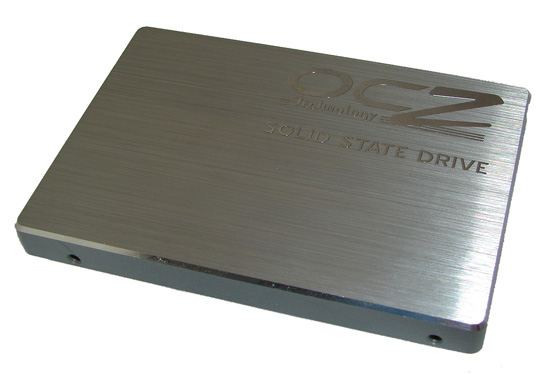64GB SSD on the Desktop: Samsung and OCZ go mainstream
by Gary Key on May 15, 2008 11:30 PM EST- Posted in
- Storage
We are seeing the SSD market mature quickly from the performance, pricing, and capacity viewpoints. Just over a year ago, the first generation SSD drives had average capacities in the 16GB range with read/write performance around 45/25 MB/s. Pricing for these drives was around the $100 per-GB range and most suppliers explicitly stated the drives were meant for industrial, military, medical, or commercial use.
Last fall, second generation controller technology became available and performance jumped to 60/40 MB/s read/write speeds for the mainstream market along with specialized manufacturers like Mtron and Memoright offering drives in the 100/80 MB/s read/write range. The new capacity standard became 32GB with 64GB performance oriented drives available. Pricing for the mainstream also dropped with costs averaging around $48 per-GB for the performance-oriented drives and around $33 per-GB for the mainstream drives.
These particular drives now had the capacity range to become an alternative in the consumer notebook market or for those enthusiasts on the desktop wanting the absolute best synthetic benchmark performance. While prices were very high, the security of a drive in a portable system not having any moving parts, offering silent operation, greatly reduced thermals, and depending on the situation, improved battery life meant the SSD had arrived as a viable if expensive storage option.

Now, with the latest controller technology we are seeing the new mainstream drives offering performance equal to the best mechanical desktop drives in most cases. The sustained read/write rates have increased to the 100/80 MB/s range. Capacities are now standardizing at 64GB with average pricing dropping to around $16 per-GB for the mainstream sector. The highest performing drives feature 120/120 MB/s read/write speeds with capacities up to 128GB, but pricing is around $29~$32 per-GB. In the high performance sector, we expect to see 150/100+ MB/s read/write performance shortly along with capacities up to 128GB around the current price range.
With that in mind, we are taking our first look at the new "mainstream" SSD technology from Samsung today that also features its fraternal twin from OCZ Technology. From a performance viewpoint, the drives are identical - as they should be since both drives share the same hardware. The only differences are in the front casing design; both feature a brushed aluminum case with the respective corporate names etched on the case. The other difference is availability as you can find the OCZ drive at leading e-tailors with pricing around $1049 for the 64GB model, while the Samsung drive is generally available as an option from leading PC manufacturers with limited retail availability.
Regardless of availability, both drives perform the same on the desktop, as we will see today. We have several other SSD drives arriving in the near future, including the new MLC based units with third generation controllers from SuperTalent, Crucial, and others that might set a new price/performance standard for SSD technology. However, we will test those drives and our samples today in a notebook platform to see how well they compare to the new mechanical drives from Seagate, Western Digital, and Hitachi.










38 Comments
View All Comments
Dobs - Saturday, May 17, 2008 - link
I like the sound of that.. a Hybrid with built in Raid (or equiv).So.... I'll have the Samsung F1 SSD3 500GB Hybrid thanks!
That's the one that includes 1 308GB platter and 3 64GB SSD's (in Raid0 equiv)
mechBgon - Friday, May 16, 2008 - link
"We waivered about presenting either drive an award."I think you meant "wavered."
Baked - Friday, May 16, 2008 - link
I know you guys get all the freebies you want, do a RAID-5 w/ these drives now!Juddog - Friday, May 16, 2008 - link
The main advantage here IMHO is the power required, heat dissipation, noise level and MTBF. Perfect for notebooks. Working as a tech I see notebook drive failures all the time. I see plenty of executive level people with notebooks that would gladly pay a few hundred extra to get a much greater extended battery time from lower power usage, and greater data protection from the MTBF, not to mention the shock levels that these drives typically have is much greater than that of a hard drive.This is excellent for people who travel around a lot and carry expensive data on their laptops. Top it off with data encryption technologies that more companies are moving into, and the access time plays an even greater roll.
strikeback03 - Friday, May 16, 2008 - link
IIRC, the tests in the Macbook Air at least showed little to no advantage in battery life from the SSD. The durability though would be nice. I personally wouldn't consider one until we can get drives upwards of 100GB for under $500.JarredWalton - Saturday, May 17, 2008 - link
MacBook Air SSD testing was actually http://www.anandtech.com/mac/showdoc.aspx?i=3226&a...">quite good. I think you're probably remembering the more recent http://www.anandtech.com/memory/showdoc.aspx?i=328...">128GB SSD follow-up where the extra performance and size of the SSD made power requirements about equal to a standard HDD.Ender17 - Friday, May 16, 2008 - link
Any results on the snapiness with these drives as seen here?http://www.anandtech.com/memory/showdoc.aspx?i=328...">http://www.anandtech.com/memory/showdoc.aspx?i=328...
tshen83 - Friday, May 16, 2008 - link
http://www.newegg.com/Product/Product.aspx?Item=N8...">http://www.newegg.com/Product/Product.aspx?Item=N8...Too bad it is out of stock. I hope STT makes more of it. 299 for 30GB of 120MB/read speed.
JarredWalton - Friday, May 16, 2008 - link
But only 40MB/s writes.semisonic9 - Friday, May 16, 2008 - link
...over it's competition? What's up with that? Would have expected 7200.11 drives, or 1tb drives, to be faster.